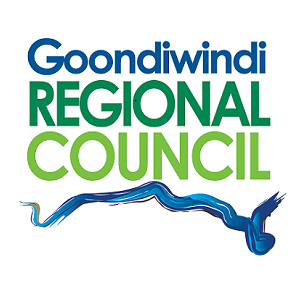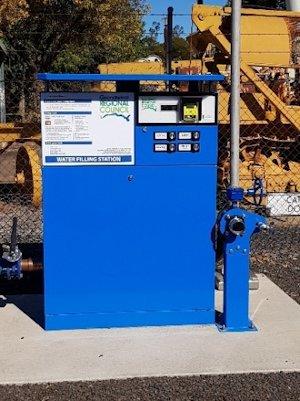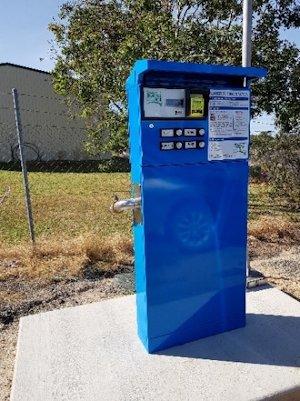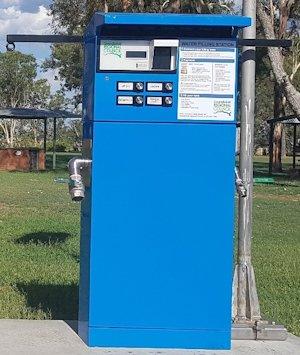Water Services
« BackGoondiwindi Regional Council is committed to maintaining high standards of Customer Service. A full set of standards have been developed and are available from any of Council's offices. For further information please view the following documents:
- Water & Sewerage Customer Service Standards
- DEWS KPI Swim Report
- SWIM KPI Cyber Security Report
- Drinking Water Quality Management Plan Report
Current Works:
Water Interruptions:
Planned Interruptions:
Refer Notices page.
Mains Flushing:
Refer Notices page.
Programmed Works:
Refer Notices page.
Water Connections:
How much does it cost for a water connection?
Water Supply Charges:
Charges apply to users connected to the Council Water Reticulation System.
Water Supply Infrastructure Charge
Water Supply Consumption Charge
Purchase of Bulk Water from a Bore:
Bore Keys:
Bore keys can be purchased annually for access to the Goondiwindi and Toobeah bore. An annual application fee is payable before a key is issued. New keys are payable each financial year (1 July to 30 June). Separate keys are issued for each bore.
Purchase of Bulk Water:
Customers now have access to bulk potable water, 24 hours a day, 7 days a week, thanks to the installation of water filling stations located in three convenient locations within the region.
- Goondiwindi - West Street Council Depot;
- Texas - Flemming Street Council Depot; and
- Inglewood - Brook Street side of Lions Park.
Water fill stations are not intended for use by residents who have access to reticulated water or are connected to the town water supply. The water is not intended for watering gardens or stock - the water is intended for customers who don’t have access to fresh clean drinking water.
Application Process
Access to water via the new filling stations will be either through credit card transactions or pre-paid account card, for approved customers. Pre- paid account cards can be applied for by completing a Water Fill Station Pre Paid Customer Card Application Form. Please allow 2 business days for assessment.
Water Fill Station Pre Paid Customer Card Application Form
Pre-paid account cards are intended for approved customers who frequently rely upon bulk domestic water deliveries for fresh, clean, drinking water.
The Credit Card transaction option is available to all other infrequent customers who do not have access to reticulated water on a town supply ie. Visitors, mobile home, caravan and motorhome customers.
Fees & Charges
- Approved pre-paid card customers will be charged at a rate of $3.70 per kilolitre with a minimum charge of $5.00
- First time pre-paid card activation fee of $40.00 will apply.
- Replacement fee of $40.00 will apply for all lost cards.
- Credit Card paying customers at the Water Fill Stations will be charged at a rate of $3.50 per kilolitre with a minimum charge of $5.00 –– No cash accepted.
- Please note, the machine does not dispense a manual receipt. Charges will appear on your bank statement as “Paymate* GRC Water”.
Water Quality
The water is potable - Council gives no guarantee of the drinking water quality once collected. Council encourages residents to engage an accredited drinking water carrier.
Nominated Collection Points
|
Goondiwindi Water Fill Station
|
Texas Water Fill Station
|
Inglewood Water Fill Station
|
Water fill station information sheet
Water fill station instructions for use
How to read your water meter:
The black/white numbers, on the left, show the reading in kilolitres. These are the numbers used for billing purposes

The white/red numbers, on the right, show litres used.
If this dial continues to move when all water taps are turned off inside the property it may indicate you have a leak.
How to read your water meter information sheet
Water Leaks:
Repairing a Water Leak on your Property
If the water leak is in one of your pipes (the property owner's pipes), you should call a licensed plumber. Please note that you will be charged for the water that your property uses while the leak remains unrepaired.
For further information please refer to GRC 0071 Concealed Water Leak Policy.
If the water leak is in one of Council's pipes, please call Goondiwindi Regional Council.
- To report a water leak during business hours contact please Council on 4671 7400
- For Council Emergencies (outside business hours) in the Goondiwindi area please call 4671 4671
- For Council Emergencies (outside business hours) in the Inglewood and Texas areas please call 4652 183
Water Conservation:
Downloads:
High Water Use Checklist for Households
There are a number of factors that may cause your water bill to increase. Slight changes within your household consumption or a concealed water leak can impact your bill. The following checklist may help you narrow down what is causing the unusually high water bill.
- Did you have any guests or extra laundry demands?
- Have you had any new water appliance or fittings installed recently?
- Do you see or hear water running or dripping from toilets, taps, pipes or hoses?
- Have you made changes to your garden?
- Is the timer working on your irrigation system?
- If you have a swimming pool is the auto-fill system working properly?
- Has your household been taking longer showers?
- Have you had any recent leaks or plumbing work completed, that could have contributed to increased water use?
- Are re-circulating pumps working on any ornamental water features?
- Check your evaporative air conditioners are functioning correctly.
Water Saving Tips for Commercial Properties
- Conduct monthly inspections of your business, focusing on piping joints, toilets, showers, taps, pump seals, hose nozzles, shut-off valves, cooling towers, etc.
- Poorly maintained equipment can often be prone to leaks. Check any equipment that uses water on a regular basis and put in place preventative maintenance schedules to help avoid potential issues.
- For underground or concealed pipe work, plumbing companies can be employed to use acoustic leak detection units and pressure testing to locate leaks.
Backflow Prevention Devices
Backflow Prevention is the term used to prevent the reverse flow of water from a potentially polluted or contaminated source into drinking and bathing water supply systems. By installing a backflow prevention device, this risk is managed. There are a number of backflow prevention devices available to suit any particular situation.
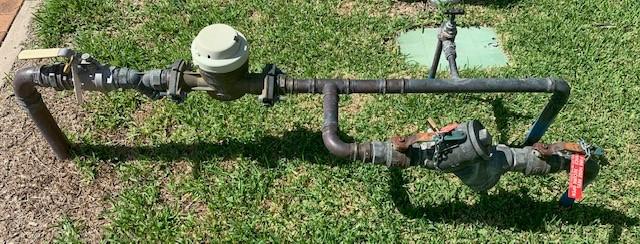
Figure 1: Typical Backflow Device
When does backflow occur?
The water supply system is designed to ensure your property is supplied with drinking water under pressure. If there is a drop in the supply pressure, there is a risk that water could flow backwards into the water main.
The water flowing back to the water mains could contain contaminates, foreign matter, or debris. This usually occurs when there is cross-connection between drinking and non-drinking water sources. The contaminated water can then come out of the mains supply at another location, with the potential to harm.
Backflow occurs because a condition exists in a water supply system that will cause back-siphonage or back-pressure.
Examples of how back-siphonage and back-pressure can occur:
- Back-siphonage can occur on a property through a vacuum created in the water supply system. An example of back-siphonage would be a pipeline breakage, undersized pipework or high withdrawal rates.
- Back-pressure occurs when the pressure within plant on a property exceeds that of the water supply mains. For example, a boiler that is chemically treated and has a higher discharge pressure than the mains supply can "force" the water back into the drinking water supply, contaminating it with chemicals.
Examples of potential source of contamination:
- Fire services
- Fire Hose Reels (FHR)
- Irrigation systems
- Vehicle maintenance pits
- Vehicle/bin washing bays
- Chemical injection areas
- Alternative water supplies
Examples of properties requiring backflow prevention:
- Motels and Hotels
- Vehicle repair workshops
- Shops
- Restaurants
- Caravan parks
- Medical and dental surgeries
- Car and plant washing facilities
- Dry cleaners and laundries
- Hospitals and funeral parlours
- Club houses for sports
- Schools
- Day care centres and kindergartens
- Abattoirs
What is the safeguard to prevent a backflow occurrence?
A correctly selected backflow prevention device (one-way valve) will eliminate any risk of contamination of the drinking water supply. Backflow devices are either testable or non-testable types with the selection dependent on the risk associated with the possible contamination.
Application and registration of a backflow prevention device
Council is required to keep a register in accordance with the Standard Plumbing and Drainage Regulation 2019.
The Licensed Plumber who inspects or tests a testable backflow prevention device must, within 10 business days after inspecting or testing the device, give local government written results of the inspection or test, along with payment of all relevant Fees and Charges.
Information on testing and registering backflow prevention devices.

